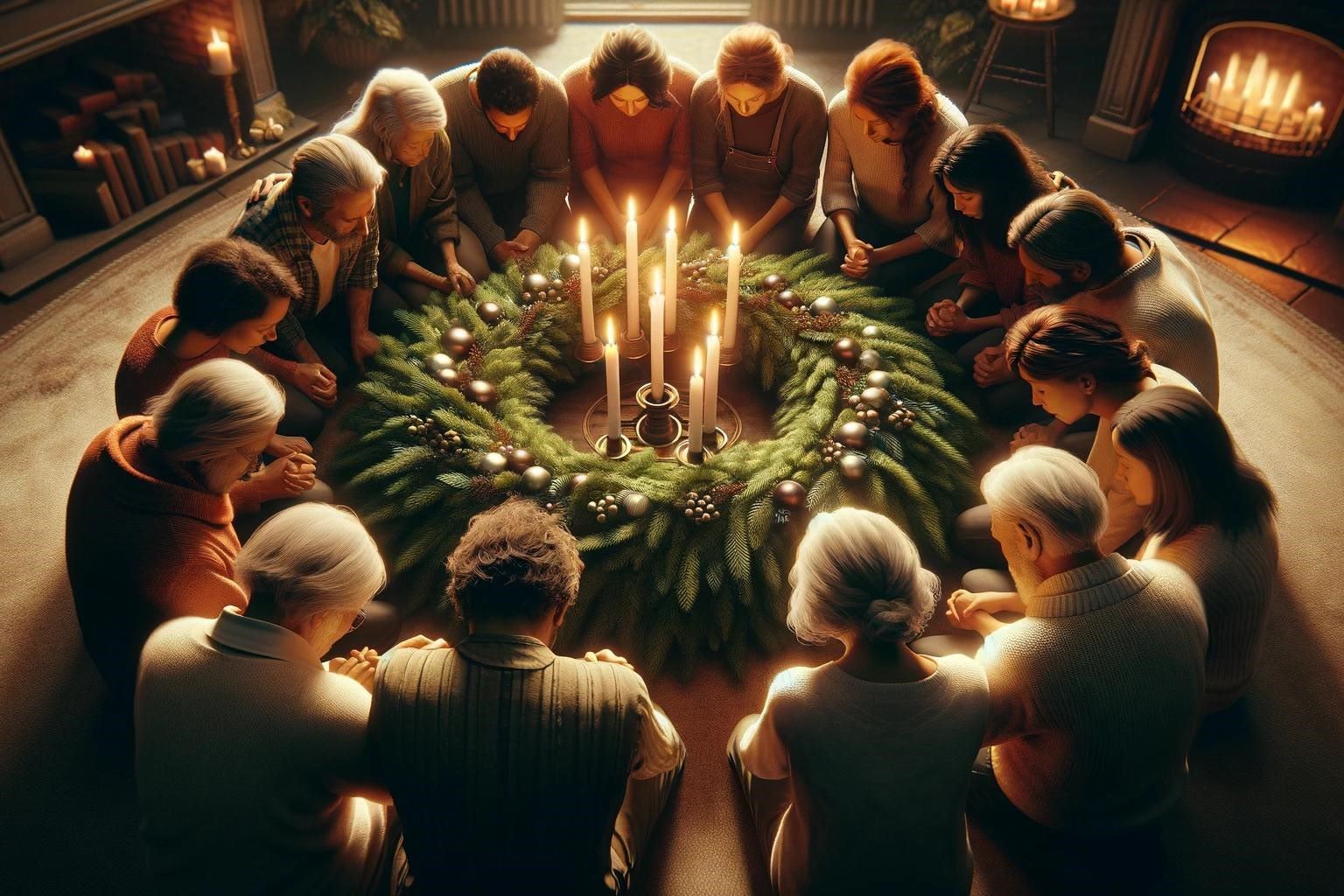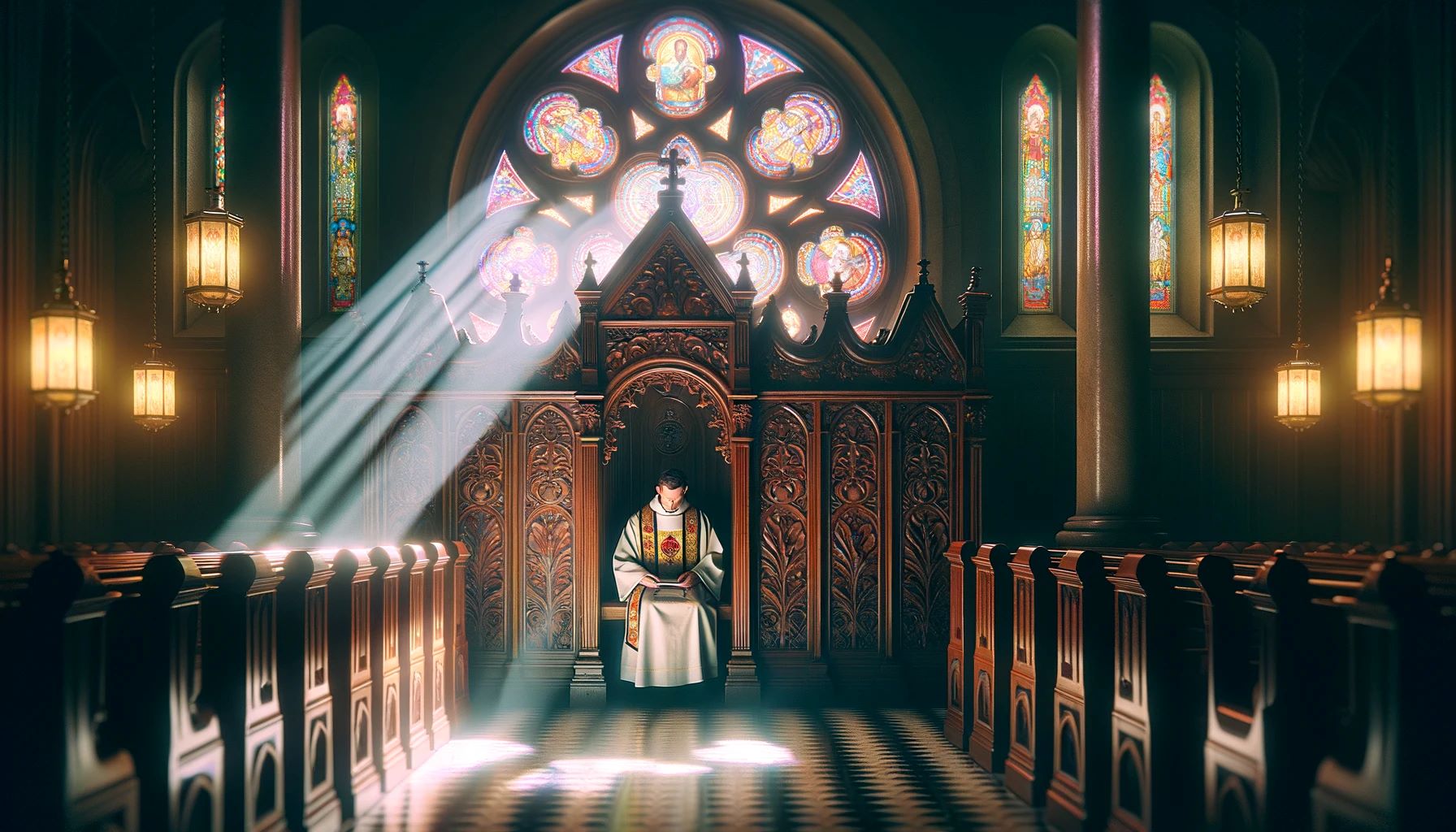Home>Special Themes>What Prayers Do You Say During Advent?


Special Themes
What Prayers Do You Say During Advent?
Published: February 14, 2024
Ericka Andersen, an editor at Christian.net, expertly merges digital strategy with content creation, focusing on faith and societal issues. Her communication skills enhance the platform's engaging narratives, fostering meaningful dialogue on belief's impact on society.
Discover the special themes and prayers for Advent to help you prepare for the Christmas season. Explore traditional and meaningful prayers for this special time of year.
(Many of the links in this article redirect to a specific reviewed product. Your purchase of these products through affiliate links helps to generate commission for Christian.net, at no extra cost. Learn more)
Table of Contents
Introduction
Advent is a time of joyful anticipation and spiritual preparation for the celebration of the birth of Jesus Christ. It marks the beginning of the liturgical year in many Christian traditions and is a period of reflection, hope, and expectation. During this sacred season, individuals and families engage in various traditions and rituals, including the recitation of prayers that hold deep significance.
As the world embraces the festive spirit and the air becomes infused with a sense of wonder, the Advent season invites us to embark on a journey of spiritual renewal and contemplation. It is a time to pause, reflect, and realign our hearts and minds with the profound significance of the nativity story. Through prayer, we seek to cultivate a sense of reverence and gratitude, acknowledging the divine presence in our lives and the promise of hope and salvation.
In the midst of the hustle and bustle of the holiday season, Advent beckons us to carve out moments of stillness and introspection. It serves as a poignant reminder to embrace the virtues of patience, faith, and love, as we eagerly await the arrival of the Christ child. The prayers offered during Advent encapsulate the essence of this season, serving as a spiritual compass that guides us through the weeks leading up to Christmas.
As we delve into the rich tapestry of Advent prayers, we embark on a journey that transcends time and space, connecting us with the faithful across generations. These prayers encapsulate the collective yearning of believers for the light of hope to dispel the darkness, echoing the sentiments of prophets and sages who awaited the fulfillment of divine promises. Whether through traditional invocations, contemporary expressions, or personalized supplications, the act of prayer during Advent becomes a sacred dialogue, weaving together the threads of tradition and personal devotion.
In the subsequent sections, we will explore the profound significance of Advent prayers, delving into traditional and contemporary forms of invocation, and uncovering the beauty of personalized supplications that resonate with individual hearts. Through this exploration, we will unravel the timeless tapestry of faith, hope, and love that defines the Advent season.
Read more: During Advent What Do We Pray For
The Meaning of Advent
Advent, derived from the Latin word "adventus," meaning "coming" or "arrival," encapsulates the profound anticipation of the birth of Jesus Christ. This sacred season, observed in various Christian denominations, serves as a period of spiritual preparation and joyful expectation. It spans the four Sundays leading up to Christmas, symbolizing the coming of light into the world and the promise of redemption.
At its core, Advent embodies a dual significance, intertwining the historical anticipation of the Messiah's birth with the contemporary longing for spiritual renewal and hope. It invites believers to journey through the narratives of ancient prophecies and the timeless message of salvation, fostering a sense of connection with the faithful of generations past.
The symbolism of Advent is encapsulated in the lighting of the Advent wreath, a cherished tradition that represents the gradual illumination of the world by the light of Christ. Each candle, lit successively on the four Sundays of Advent, symbolizes themes of hope, peace, joy, and love, culminating in the central Christ candle, which radiates the fullness of divine light on Christmas Day.
Moreover, the color purple, often associated with royalty and penitence, adorns the liturgical vestments and decorations during Advent, signifying both the solemnity of the season and the anticipation of the coming King. In some traditions, a rose-colored candle or vestments are used on the third Sunday of Advent, known as Gaudete Sunday, symbolizing rejoicing amidst the penitential preparation.
Beyond its historical and liturgical dimensions, Advent holds a deeply personal significance for individuals and families. It serves as a poignant reminder to pause amidst the flurry of holiday preparations, cultivating a spirit of contemplation and gratitude. Through the observance of Advent, believers are invited to rekindle the embers of faith, nurturing a sense of hope that transcends the transient joys of the season.
In essence, Advent beckons us to embrace the timeless message of Emmanuel, "God with us," as we eagerly await the celebration of the Incarnation. It calls us to journey through the corridors of time, uniting our hearts with the collective yearning of humanity for the fulfillment of divine promises. As we immerse ourselves in the rich tapestry of Advent, we are reminded that amidst the ephemeral trappings of the season, the true gift lies in the eternal hope and love embodied in the Christ child.
This section is 327 words long.
Traditional Advent Prayers
Traditional Advent prayers encapsulate the timeless yearning for the fulfillment of divine promises and the anticipation of the Messiah's birth. Rooted in centuries-old liturgical traditions, these invocations echo the voices of prophets and sages who heralded the advent of the long-awaited Savior. They serve as spiritual beacons, guiding believers through the sacred season with reverence and contemplation.
One of the most iconic traditional Advent prayers is the "O Antiphons," which date back to the early centuries of the Church. These antiphons, often chanted or recited during Vespers from December 17th to 23rd, address the Messiah with titles derived from Old Testament prophecies. Each antiphon reflects a different aspect of the Messianic promise, invoking the depth of longing for the coming of the Christ child.
The "Magnificat," or the Canticle of Mary, also holds a central place in traditional Advent prayers. This hymn of praise, found in the Gospel of Luke, resounds with the exultant proclamation of Mary as she rejoices in the fulfillment of God's promises through the impending birth of Jesus. It embodies the spirit of joyful anticipation and humble submission to the divine will, resonating with the themes of hope and salvation that define the Advent season.
Additionally, the "Advent Prose" or "Rorate Coeli," originating from medieval liturgical traditions, is a poignant supplication that beseeches the heavens to rain down the long-awaited Savior. Its haunting melody and evocative lyrics evoke the yearning of the faithful for the dawning of redemption, intertwining themes of light, darkness, and the imminent arrival of Emmanuel.
Moreover, traditional Advent prayers often incorporate the Psalms, particularly those that express longing for divine intervention and the restoration of God's people. Psalms such as 80, 85, and 89 resonate with themes of restoration, mercy, and the steadfast love of the Lord, providing a rich tapestry of supplication and praise during the Advent season.
In essence, traditional Advent prayers serve as a bridge that connects believers across time and space, uniting their hearts with the collective yearning for the fulfillment of divine promises. Through these timeless invocations, the faithful are invited to immerse themselves in the sacred narrative of anticipation and hope, embracing the profound significance of the Advent season.
This section is 331 words long.
Contemporary Advent Prayers
In the tapestry of faith, contemporary Advent prayers emerge as vibrant threads that weave together the timeless themes of hope, anticipation, and spiritual longing with the complexities of modern life. These invocations, often reflective of the evolving language and experiences of believers, encapsulate the enduring relevance of the Advent season in the present day.
Contemporary Advent prayers resonate with the aspirations and challenges of the contemporary world, offering a poignant reflection of the human experience amidst the hustle and bustle of daily life. They often incorporate language and imagery that speak to the yearnings and struggles of individuals and communities, infusing the ancient tradition of Advent with a sense of immediacy and relevance.
In many contemporary settings, Advent prayers embrace inclusive language and themes that acknowledge the diverse tapestry of human experiences. They may encompass prayers for peace in conflict-torn regions, healing for those affected by illness or adversity, and comfort for the marginalized and oppressed. These invocations reflect the interconnectedness of humanity and the universal longing for hope and redemption, transcending cultural and geographical boundaries.
Moreover, contemporary Advent prayers often draw upon the rich reservoir of modern poetry and music, infusing the sacred season with evocative expressions of longing and anticipation. Through contemporary hymns, songs, and poetic invocations, believers find resonance with the emotional landscape of the present age, articulating their yearning for spiritual renewal and the dawning of divine light in a world marked by uncertainty and turmoil.
Additionally, the digital age has ushered in new forms of contemporary Advent prayers, with online communities and social media platforms becoming spaces for collective supplication and reflection. Virtual prayer gatherings, interactive devotional resources, and digital art installations centered around Advent themes offer avenues for individuals to engage with the sacred season in innovative and interactive ways, fostering a sense of communal connection and shared spiritual journey.
In essence, contemporary Advent prayers serve as a testament to the enduring relevance of the Advent season in a rapidly changing world. They embody the timeless yearning for hope and redemption while embracing the complexities and nuances of modern existence, offering a tapestry of invocations that resonate with the hearts of believers in the present age.
This section is 325 words long.
Personalized Advent Prayers
Personalized Advent prayers offer individuals a deeply intimate and heartfelt means of engaging with the sacred season. These bespoke invocations spring from the depths of personal faith and experience, weaving together the tapestry of individual stories with the timeless themes of hope, anticipation, and spiritual longing.
In crafting personalized Advent prayers, individuals draw upon their unique journeys, aspirations, and challenges, infusing the traditional rhythms of the season with the hues of their personal narratives. These prayers often reflect the joys and sorrows, triumphs and tribulations, and the ebbs and flows of life, resonating with the raw authenticity of human experience.
At the heart of personalized Advent prayers lies a profound sense of vulnerability and honesty, as individuals lay bare their deepest longings and aspirations before the divine. These invocations become a sacred dialogue, a soulful conversation with the divine, where individuals express their yearning for healing, restoration, and spiritual renewal in the midst of their personal landscapes.
Moreover, personalized Advent prayers often encompass expressions of gratitude for the blessings received, acknowledging the moments of grace and illumination that have punctuated the journey. They serve as poignant reminders of the enduring presence of hope and love, even amidst the shadows of doubt and despair, offering a testament to the resilience of the human spirit.
In the act of crafting personalized Advent prayers, individuals may draw inspiration from their own creative expressions, infusing their invocations with the cadence of poetry, the resonance of music, or the vivid imagery of visual art. These multidimensional prayers become a symphony of the senses, engaging heart, mind, and spirit in a harmonious chorus of devotion and longing.
Furthermore, personalized Advent prayers often extend beyond individual supplications, encompassing intercessions for loved ones, communities, and the world at large. They become a conduit for empathy and solidarity, as individuals lift up the collective yearnings and struggles of humanity, seeking solace and redemption for all who traverse the labyrinth of human existence.
In essence, personalized Advent prayers embody the deeply personal and universal dimensions of faith, weaving together the individual threads of human experience with the timeless tapestry of hope and anticipation. Through these bespoke invocations, individuals find a sacred space to lay bare their hearts, offering their deepest longings and aspirations as incense rising to the heavens, as they journey through the hallowed season of Advent.
This section is 349 words long.
Read more: What Do We Reflect On During Advent
Conclusion
As we draw the curtains on our exploration of Advent prayers, we find ourselves enveloped in the timeless embrace of hope, anticipation, and spiritual longing that define this sacred season. From the hallowed echoes of traditional invocations to the vibrant hues of contemporary expressions and the deeply personal cadence of personalized supplications, the tapestry of Advent prayers resonates with the collective yearning of humanity for the dawning of divine light.
In the mosaic of faith, Advent prayers stand as luminous beacons, guiding believers through the corridors of time and tradition, inviting them to immerse themselves in the sacred narrative of anticipation and hope. They encapsulate the profound significance of the Advent season, serving as a spiritual compass that navigates hearts and minds through the weeks leading up to Christmas.
Through the recitation of traditional Advent prayers, individuals find themselves in communion with the faithful across generations, uniting their voices with the timeless yearning for the fulfillment of divine promises. The haunting strains of the "O Antiphons," the exultant proclamation of the "Magnificat," and the poignant supplication of the "Advent Prose" intertwine with the Psalms, weaving a tapestry of reverence and contemplation that transcends time and space.
In the vibrant landscape of contemporary Advent prayers, believers encounter invocations that resonate with the complexities and nuances of modern existence. These prayers embrace inclusive language and themes, acknowledging the interconnectedness of humanity and the universal longing for hope and redemption. They infuse the ancient tradition of Advent with a sense of immediacy and relevance, offering a tapestry of invocations that speak to the hearts of believers in the present age.
Moreover, personalized Advent prayers become a sacred dialogue, a soulful conversation with the divine, where individuals express their deepest longings and aspirations. They embody the deeply personal and universal dimensions of faith, weaving together the individual threads of human experience with the timeless tapestry of hope and anticipation.
As we stand on the threshold of Christmas, the echoes of Advent prayers linger in the air, carrying the collective yearning of believers across time and space. They serve as a testament to the enduring relevance of the Advent season, offering a symphony of invocations that resound with the timeless message of hope, love, and the promise of redemption.
In the gentle glow of candlelight and the strains of sacred melodies, Advent prayers beckon us to embrace the virtues of patience, faith, and love, as we eagerly await the arrival of the Christ child. They remind us that amidst the transient trappings of the season, the true gift lies in the eternal hope and love embodied in the nativity story.
This section is 398 words long.














